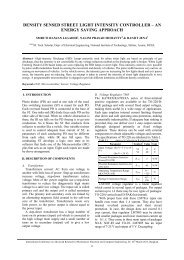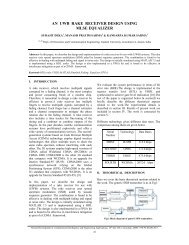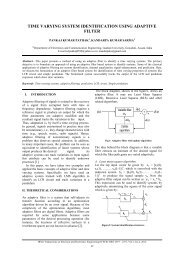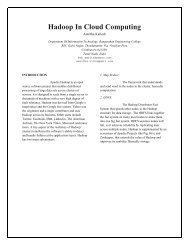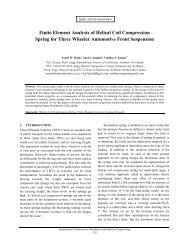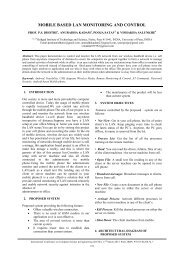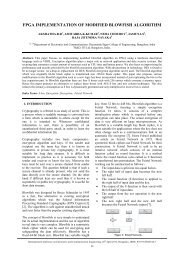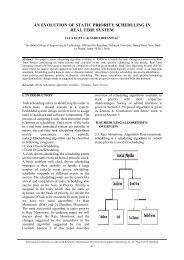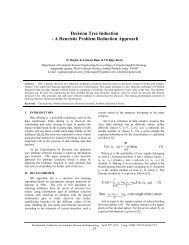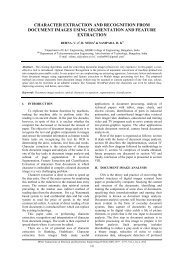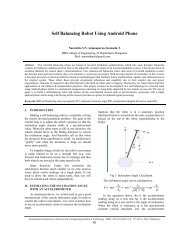HAKI-NFC Based Android Application - IRNet Explore
HAKI-NFC Based Android Application - IRNet Explore
HAKI-NFC Based Android Application - IRNet Explore
You also want an ePaper? Increase the reach of your titles
YUMPU automatically turns print PDFs into web optimized ePapers that Google loves.
<strong>HAKI</strong>-<strong>NFC</strong> <strong>Based</strong> <strong>Android</strong> <strong>Application</strong><br />
amounts of data can be stored and can be sent to <strong>NFC</strong><br />
devices. The data stored on the <strong>NFC</strong> tag may contain<br />
any form of data such as URL, phone number and text.<br />
In fact, any mime data type can be stored in <strong>NFC</strong> Tags.<br />
2) Tag Types<br />
A wide variety of <strong>NFC</strong> tags exist. However, this is a<br />
list of standard specification by the <strong>NFC</strong> Forum. To be<br />
<strong>NFC</strong> Forum-compliant the tags have to follow these<br />
specifications.<br />
<strong>NFC</strong> Forum Type 1 Tag Operation Specification [1] .<br />
Type 1 tag is based on ISO14443A. Tags are read and<br />
re-write capable; users can configure the tag to become<br />
read-only. Memory availability is 96 bytes and<br />
expandable to 2 Kbyte; communication speed is 106<br />
Kbit/s.<br />
<strong>NFC</strong> Forum Type 2 Tag Operation Specification [2] .<br />
Type 2 tag is based on ISO14443A. Tags are read and<br />
re-write capable; users can configure the tag to become<br />
read-only. Memory availability is 48 bytes and<br />
expandable to 2 Kbyte; communication speed is 106<br />
Kbit/s.<br />
<strong>NFC</strong> Forum Type 3 Tag Operation Specification [3] .<br />
Type 3 tag is based on the Japanese Industrial Standard<br />
(JIS) X 6319-4, also known as Felicia. Tags are preconfigured<br />
at manufacture to be either read and rewritable,<br />
or read-only. Memory availability is variable,<br />
theoretical memory limit is 1MByte per service;<br />
communication speed is 212 Kbit/s or 424 Kbit/s.<br />
<strong>NFC</strong> Forum Type 4 Tag Operation Specification [4] .<br />
Type 4 tag is fully compatible with ISO14443A and B<br />
standards. Tags are pre-configured at manufacture to be<br />
either read and re-writable, or read-only. Memory<br />
availability is variable, up to 32 Kbytes per service;<br />
communication speed is up to 424 Kbit/s.<br />
C. Tag Shapes<br />
There is variety of shapes of <strong>NFC</strong> Tags available.<br />
They can be rectangular, circle or custom made. Some<br />
of the tags are washable also so that they can be attached<br />
to clothes. Some of them are in form on cards. Some<br />
tags can be used as stickers.<br />
D. NDEF Format<br />
<strong>NFC</strong> Forum Data Exchange Format is a lightweight<br />
binary message format designed to encapsulate one or<br />
more application-defined payloads into a single message<br />
construct [5] . Its light weight because it doesn’t include<br />
significant overhead. An NDEF Message can<br />
encapsulate one or more NDEF Record. The size of<br />
NDEF record can be of up to 2 32 -1 octets in size. NDEF<br />
record can be chained together to contain larger payload<br />
size. NDEF Records contain three parameters for<br />
describing its payload. They are<br />
1. Payload length: It describes the number of octets<br />
the payload contains.<br />
2. Payload Type: It indicates the Type of payload<br />
encapsulated. NDEF supports URIs, MIME media<br />
type constructs, and an <strong>NFC</strong>-specific type format as<br />
type identifiers. Indicating the type of payload helps<br />
to dispatch the payload to the appropriate user<br />
application.<br />
3. Payload Identifier: It is optional and enables<br />
payloads that support URI linking technologies to<br />
cross-reference other payloads.<br />
Existing issue :<br />
Fig. 1 : NDEF Message Construct<br />
There are over 5 billion tags deployed which do not<br />
contain the NDEF format.<br />
1. Transit<br />
2. Credit cards<br />
3. Passports<br />
4. Physical access cards<br />
So the systems which are to be developed should<br />
consider the legacy tags and support them because they<br />
are already being deployed. However if you can control<br />
the tag which will be developed it will be better use<br />
NDEF tags because they are standardized by the <strong>NFC</strong><br />
Forum.<br />
Moreover the QR codes which involves tedious<br />
method to go to a particular website can be easily<br />
replaced by Smartposter which will direct user to the<br />
site just by touch<br />
E. Reader<br />
NDEF<br />
Record 0<br />
The reader is an active device, which generates<br />
radio signals to communicate with the tags. The reader<br />
powers the passive device in case of passive mode of<br />
communication. The reader/writer can be a dedicated<br />
<strong>NFC</strong> reader/writer or <strong>NFC</strong> enabled phones.<br />
F. Communication modes<br />
NDEF<br />
Record 1<br />
NDEF<br />
Record n<br />
<strong>NFC</strong> devices support two communication modes.<br />
<strong>IRNet</strong> Transactions on Computer Science and Engineering<br />
14





